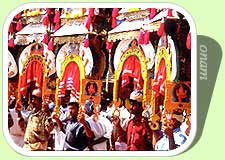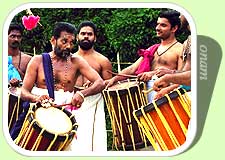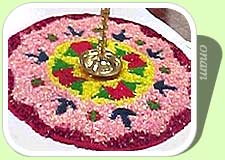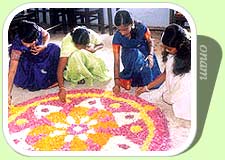Vishu (Malayalam:വിഷു) is a new year festival celebrated in the state of Kerala, India. It is similar to the New Year festivals observed elsewhere in India like Baisakhi (Punjab), Bihu (Assam), Naba Barsha (Bengal), Bisu (Tulu Nadu region in Karnataka), (Vishuva Sankranti) in Orissa and Puthandu (Tamil Nadu). Vishu generally falls on April 14 of the Gregorian calendar. This occasion signifies the Sun's transit to the zodiac - Mesha Raasi (first zodiac sign) as per Indian astrological calculations and astronomically represents the vernal equinox. "Vishu" in Sanskrit means "equal". Therefore Vishu is more probably denoting one of the equinox days. Although Vishu (first of Medam) is the astrological new year day of Kerala, the official Malayalam new year falls on the first month of Chingam (August - September). However, 1st of Chingam has no significance either astrologically or astronomically. Chingam is the harvest season in Kerala and southern parts of coastal Karnataka.
The most important event in Vishu is the Vishukkani, which literally " the first to be seen on the Vishu day". The Vishukkani consist of a ritual arrangement of auspicious articles like raw rice, fresh lemon, golden cucumber, betel leaves, arecanut, metal mirror, the yellow flowers konna (Cassia fistula), and a holy text and coins, in a bell metal vessel called uruli in the puja room of the House. A lighted bell metal lamp called nilavilakku is also placed alongside. This arrangement is completed the previous night. On the day of Vishu, the custom is to wake up at dawn and go to the puja room with the eyes closed so that the Vishukkani is the first sight of the new season. Since the occasion marks the beginning of Malayalam New Year, it is also considered auspicious to read verses from Hindu Holy book Ramayanam after seeing the "Vishukkani". It is also believed that the page of the Ramayanam to which you open up will have a bearing on your life in the coming year. Devotees also throng the well-known temples like Sabarimala Ayyappan Temple, Guruvayur Sree Krishna temple to have a "Vishukkani Kazhcha" on the early hours of "Vishu" day.
"Vishu" is celebrated with much fanfare and vigour in all parts of Kerala.[citation needed] Bursting crackers is part and parcel of the celebration especially for children. Elders gift firecrackers to children and every child vie with each other to make a world of their own. People wear new clothes (Puthukodi) for the occasion and elders of the family distribute tokens of money, called Vishukkaineetam, to children, servants and tenants.
Vishu is also a day of feasting, wherein the edibles consist of roughly equal proportions of salty, sweet, sour and bitter items. Feast items include Veppampoorasam (a bitter preparation of neem) and Mampazhapachadi (a sour mango soup).
Tradition
The Malayalam word kani literally means "that which is seen first," so "Vishukkani" means "that which is seen first on Vishu." Arranged in the family puja room the night before by the mother in the family, the Vishukkani is a panorama of auspicious items, including flowers, fruits and vegetables, clothes and gold coins. In Jyotiṣa(Indian astrology), Vishnu is seen as the head of Kaala Purusha, the God of Time. As Vishu marks the first day of the Zodiac New Year, it is an appropriate time to offer oblations to Hindu Gods.
[edit] Solar New Year
Vishu is traditionally celebrated as the Malayalam New Year, especially in the central and northern areas of the state. However, Chingam (August - September) is officially the first month of Kollavarsham, the Malayalam calendar. First day of Chingam is of no particular significance astrologically.
[edit] Vishukkani or Kanikanal
The Vishukkani, also called Kanikanal, is inseparable from Vishu. According to the age-old belief of Malayalees, an auspicious kani (first sight) at the crack of dawn on the Vishu day would prove lucky for the entire year. As a result, the Vishukkani is prepared with a lot of care to make it the most positive sight so as to bring alive a wonderful, propitious and prosperous new year!
Normally, the responsibility to put the Kani in order falls on the experienced shoulders of the eldest lady of the house. A traditional Kani is prepared as described below. There could be minor deviations from place to place.
There are also beliefs that if you do not see a proper Vishukkani, then you will lose a year from your life or have bad luck, depending on how much you see.
[edit] Vishukani Preparation
A reasonably sized Uruli is used to arrange the Kani. Uruli is an open-mouthed shallow circular vessel made out of bell metal. It is available in all sizes from a diameter of a few inches to even 10–12 feet! Of course, the bigger ones are called charakku, odu etc. The uruli traditionally is made of panchaloham, an aggregate of five metals. Panchaloham being symbolic of the universe, which comprises the five great elements—earth, water, fire, air and space.
In kollam areas, Akshatam, a mixture of rice and turmeric, which is divided into halves of husked and un-husked rice, is placed in uruli. While in other parts of kerala, Unakkalari (raw rice) is the first ingredient that goes into the Kani Uruli to act as a support base for the other items to be positioned.
Placed over that is a freshly laundered white kasavu pudava (a typical Kerala style Sarang with golden embroidery), followed by a carefully selected Kanivellari (golden coloured, shapely cucumber), Vettila (betel leaves), Pazhukkapakku (reddish yellow coloured ripe areca nut), golden coloured mango fruit, ripe yellow jack fruit(halved) and a shining brass valkannadi (hand mirror).
A nice, well-starched cloth is then pleated fan-like and inserted into a highly polished brass kindi (a spouted puja vessel used for pouring sacred water). The val-kannadi, a special type of mirror with an extremely long and thin handle, often decorated with gold, is also inserted into the kindi. The kindi is then placed in the uruli on top of the rice.
In many places, Ramayanam or any of the scripttures written on Palm leaves (also called as Thaaliyola) is also added to the auspicious constituents of the Kani arranged in this Uruli. Similarly, Ashtamangallyam may also be is kept in the Kani Uruli. After this, a gold coin or gold ornament is placed on top of all. Then keep a pair of halved coconuts upright, filled with oil along with cotton wicks.
Then in a small flat-bottomed vessel is kept a little rice, a silver coin and some flowers. After the Kanikanal, thinking of a wish, if one takes the coin and check if its top side is head or tail. Depends on this one may know if his/her wish would be realized or not.
Now keep the Kani Uruli in front of the statuette or picture of Sree Krishna Bhagavan (in Northern Kerala, the valkannadi signifies or is the embodiment of Sree Bhagavathi, the Jaganmata Jagadeeswari). Then decorate the Kani Uruli, Picture and the surroundings with Konnappoovu (Indian Laburnum. See Box). Place a lit Nilavilakku (bronze oil lamp) nearby in such a way as it imparts a golden yellow hue to the Kani-ambience.
Two deepams, which are fashioned from the two halves of a split coconut, are also kept in the uruli. The wicks are made from pieces of starched cloth that are folded into bulbs at the base. These bulbs are placed into the coconut oil that fills the deepams, anchoring the wicks in place. The starch helps the rest of the wick to extend straight upwards so that they will properly burn. The lighting of the deepam welcomes God into our lives and is also symbolic of spiritual knowledge—the remover of the darkness of ignorance.
Now the subdued yellow splendour of Nilavilakku and its brilliant reflections on the bronze Uruli, golden coloured kanivellari, gold ornaments and bronze mirror boost the overwhelmingly yellow abundance of the Kanikonna flower clusters and in turn augment the beauty of the yellow clad divinity that is Lord Sree Krishna Paramatma. When one opens the eyes for the first time in the Brahma Muhurtha, to look at Bhagavan’s this glorious image, where is the chance that any thing can go wrong in the new year, why the whole life?
Gold—both in colour and in coin—is central to the Vishukkani. Kanikkonna, a golden-yellow flower is used liberally throughout the puja room. This flower only blooms when the sun is in its most exalted position astrologically—the month surrounding Vishu. In the puja room, the flower verily represents the sun itself, the eyes of Lord Vishnu. Gold coins are symbols of monetary affluence, as well as cultural and spiritual wealth, which the elders of the family must share freely with the younger generation. Vishukkaineettam, the distribution of wealth, is another aspect of the festival. It should be given freely and accepted with reverence. On Vishu, the highly affluent families will not only give money to their children but also their neighbours, perhaps the entire village.
The grandmother or mother who arranges the Vishukkani will sleep in the puja room after she is finished and then, waking during the auspicious hour of the Brahma muhurata (4:00 to 6:00 a.m.), she will light the oil-lamp wicks and take in the auspicious sight. She will then walk to the rooms where the rest of the family is sleeping and wake them. Covering their eyes, she will then lead them to the puja room, where she will allow them to take in the auspicious sight.
Upon opening one's eyes, one is overwhelmed with the glorious darshan of the Lord. The mirror—which is symbolic of Bhagavati (Devi), not only increases the lustre of the Vishukkani via the reflection it offers, but also shows our own face. One may also be reminded at this time, that Bhagavan SriKrishna is the supreme lord of all that be, and our eternal duty(Sanatana Dharma) as eternal spirit souls (jivatma) is to render devotional service unto the Him, utilizing all these material requirements provided by Him for our well-being in the coming year also. The mirror also points to the importance of making our mind pure enough to render devotional service (Nava vidha bhakti) with true and unadulterated love to SriKrishna.
The Vishukkani is not reserved only for those who come to the puja room, but is taken around—for the viewing of the elderly and sick who are perhaps too frail to come to the shrine. It is also brought outside and shown to the family cows. As it is brought to the cowshed, it in fact is on display for the birds, the trees, for all of nature to see.
Vishukkani points to a year of abundance—both spiritually and materially. Food, light, money, knowledge—all should fill our life. Taking in the Vishukkani we should pray that the vision remains with us throughout the year. It is not enough that the joy we take from viewing the Vishukkani comes only to our eyes. It must reflect in our thoughts and in our actions. The auspicious start of the year—which has come to us due to the grace of beginning it with a divine vision—is not for us alone. It is up to us to spread this love, happiness and hope to the rest of society.
[edit] Kanikanal
After preparing the Kani on the night of the Vishu eve, the eldest lady of the house (grand mother, mother or the eldest sister) would sleep near to the Kani, keeping the match box close at hand. She gets up much before the Lord of the Day rises above the eastern horizon. Keeping the eyes closed, she lights up the lamps and with prayers on lips, she opens her eyes to behold the golden scene that spreads in front and the image of the ever smiling face of Balagopala. After her Kanikanal, she wakes up other family members one by one and guides them to see the Kani in the Pooja Room. The children are brought keeping their eyes covered by her loving hand or a cloth to prevent them from opening the eyes and see the mundane before seeing the divine.
After the human beings, it is the turn of the plants, animals and all things movable and immovable. The Kani Uruli is then taken outside to show them. It is also taken to the cattle shed, bank of the ponds etc. and finally around the house three times.
In some places, children and youth prepare the Kani and take it around the neighbourhood chanting Keerthanams accompanied with musical instruments. They get Kaineetam from all the houses they visit.
Vishukani is important in many famous temples such as Ambalappuzha Sri Krishna Temple, Guruvayur Temple and Sabarimala.
[edit] Vishu Kaineetam
Children wait eagerly for this ritual. The elders of the family starting with the grand father or father give away Kaineetam to the younger ones. The Kaineetam consists of coins (now mostly notes) with Konna flowers, rice and the gold from the Uruli. The gold and the rice are returned to the Uruli and touch the eyes with flower. Earlier days, it was a custom to give Kaineetam to all the people associated with the house such as servants, field workers and land-tenants. The principle is the symbolic sharing of the prosperity and wishing happiness for all.
[edit] Vishu Kanji
Saddhya is a major part of all Kerala festivals. But for Vishu, Vishu Kanji and Thoran are more important. The Kanji is made of rice, coconut milk and spices. For the side dish, that is Thoran also there are mandatory ingredients.
[edit] Vishu Padakkam
Fireworks is an important part of Vishu celebration in many parts of North Kerala. In the morning and the previous evening, children enjoy bursting crackers.








 Kerala appears in its grandiose best on this day. Cultural extravaganza, music and feasts add colours of merriment and joy to the God's Own Country. There are celebrations all around the state and everybody takes active participation in them; Onam has assumed a secular character and is celebrated by people of all religions and communities.
Kerala appears in its grandiose best on this day. Cultural extravaganza, music and feasts add colours of merriment and joy to the God's Own Country. There are celebrations all around the state and everybody takes active participation in them; Onam has assumed a secular character and is celebrated by people of all religions and communities.
 Ritual of making the flower mats continues for all ten days of Onam. Designing starts from the day of Atham and is made ready by Thiruvonam day. Basic design is prepared on the first day. Size of a Pookalam is increased by adding more to it on every passing day hence a massive Pookalam gets ready for the main day of the occasion. Its a big creative task, as designers have to think of a new design ever day.
Ritual of making the flower mats continues for all ten days of Onam. Designing starts from the day of Atham and is made ready by Thiruvonam day. Basic design is prepared on the first day. Size of a Pookalam is increased by adding more to it on every passing day hence a massive Pookalam gets ready for the main day of the occasion. Its a big creative task, as designers have to think of a new design ever day.




 CAclubindia
CAclubindia
